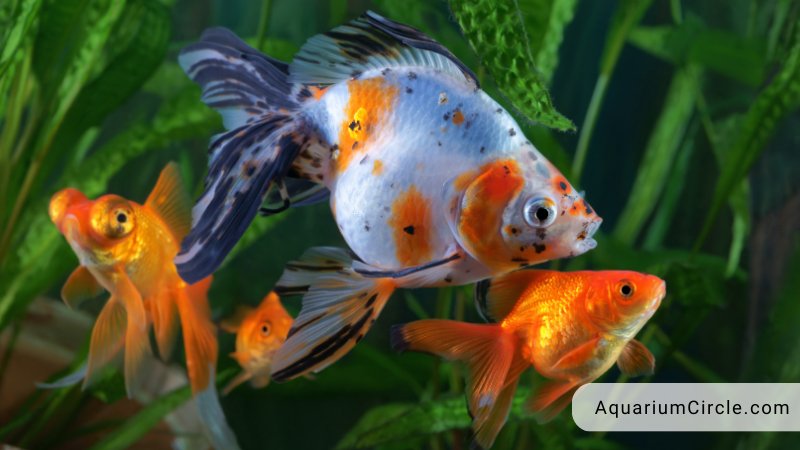“Why is my goldfish turning black?” We have the answer for you! Many aquarists wonder why their goldfish is suddenly changing color and become alarmed at the sight of a black goldfish. While it can be alarming, there are actually many common reasons why this can occur. In this article, we will discuss 10 of the most common reasons your goldfish might be turning black, as well as what you should do in each case. So if you’re asking yourself “why is my goldfish turning black?”, read on to learn more about potential causes and solutions.
There are many reasons that make your normal goldfish suddenly change into black, such as genetic, camouflage, amonia burns, black spot disease, overfeeding, stress, injuries,… Each reason comes with different treatment; keep reading to get more information so that you can determine which case does your goldfish belong to.
See also:
- 5 Reasons Why Black Goldfish Turning Gold & Best Solutions
- Goldfish Nitrate Poisoning: How To Avoid & 7 Cures (in Short And Long Term)
- Why Do Goldfish Die So Fast? – Here Are 7 Reasons Why!
Reasons For Why Is My Goldfish Turning Black
As you can see right at the title, in this post we will go through 10 most common reasons why your goldfish’s body is changing into black.
Turning black due to genetics
We’ll start with a factor that is comparatively unimportant. Some kinds of goldfish have black colour in their DNA, which appears between the first and second years of development. There is no need to be concerned about your goldfish’s health if their color changes because genetic predisposition is a fully natural occurrence.
Unreliable breeders of mixed breed goldfish are more likely to cause them to turn black as they mature from juvenile to adult status. These less expensive goldfish will have odd colorations from the considerable cross-breeding, which might eventually turn into black spots.
That is not to argue that dark spots never appear in purebred goldfish. On the other hand, goldfish from reliable breeders can change color, although it typically begins as tiny, black dots or streaks on the fins. These black marks will enlarge with time.
If your goldfish naturally become black due to genetics, there is nothing to worry about. You may expect typically healthy fish. There is another reason for the color shift, though, if your goldfish’s normal color does not contain dark pigment variation.
Blending into its environment
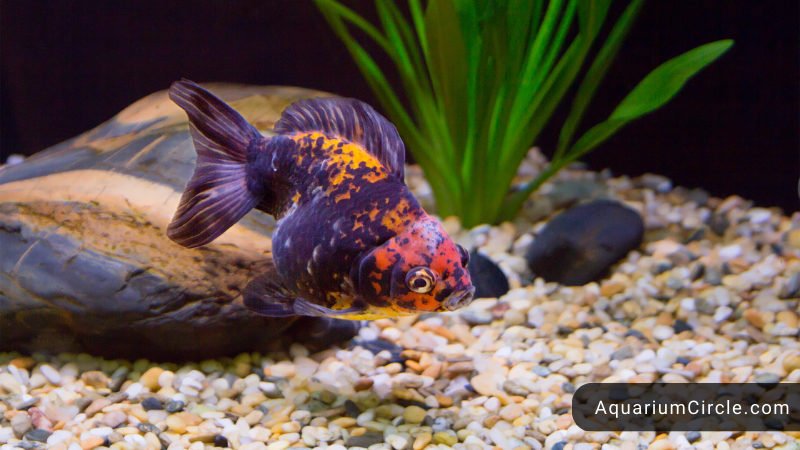
Goldfish are considered as well-adjusting creatures, they can blend into their living space over time. This is one of the most common reasons why goldfish turn to black color.
As a result, if you recently bought a goldfish and put it in an aquarium with a dark background, black backdrop, or dark wallpaper, don’t be surprised if it starts to become black!
Goldfish contain color cells implanted under their skin, much like the majority of fish. The majority of goldfish have black tails, which is a result of some of these cells producing the dark pigment melanin. Your fish will also turn black in a dark environment due to this pigment.
Goldfish that are kept in the dark have a natural inclination to blend into their surroundings as a protective measure. To achieve this, their cells will generate additional melanin, allowing them to appear black and blend in with the environment, thus concealing themselves from danger. The melanin may cover the entire body or be visible through patches on its scales, fins, or tails.
Goldfish turn black is due to ammonia burns
Ammonia poisoning might potentially be the cause of your goldfish’s blackening. Ammonia is a poisonous toxin that is harmful to all fish, not only goldfish. Even 2 ppm of ammonia can kill your goldfish.
Ammonia buildup in the fish tank can be caused by fish waste, rotten food, dead plants, dead fish, insufficient filtration, or having too many fish kept.
When goldfish expose to ammonia, the skin and gills of them will be burned. Sadly, ammonia burns are invisible to the naked eye. Goldfish do not get black patches until their bodies have begun to recover.
However, you shouldn’t assume that goldfish being black means the ammonia levels have decreased. Even in situations when the ammonia levels are high, this type of fish will try to treat the burns. Ammonia burn can also manifest as difficult breathing, irregular swimming, and inflamed gills.
To determine whether ammonia poisoning is the cause of your goldfish’s blackening, use an ammonia test kit. Check for nitrites as well, as these are very harmful.
Below is a video about how to lower ammonia levels in goldfish tank:
Perform a 50% water change once you’ve established that the ammonia burn is what caused the black patches. To lower ammonia levels, perform a weekly 25% water changeu. You can use ammonia removal products as an alternative.
In order to avoid ammonia spikes, you should:
- Set Up A Powerful Filtration System: A filter will keep the water clean and serve as a home for the aquarium’s beneficial bacteria. Choose filters that can filter materials mechanically, chemically, and biologically.
- Change Water Frequently: Since these fish are filthy, routine tank care is also essential. Make careful to vacuum the substrate and clean the interior of the aquarium’s glass.
- Insert live plants: Ammonia levels are immediately absorbed by plants through their roots. They use this substance to expand, which helps keep the water’s quality stable.
- Don’t overfeed your goldfish: Avoid overfeeding and throw out any uneaten food since it might spark ammonia. Give your goldfish just enough food to last them a few minutes, not an entire day.
- Don’t keep too many goldfish in the goldfish tank: Due to the large bioload that goldfish create, an overcrowded tank is a surefire way to cause ammonia poisoning. Give goldfish 1 gallon of water for every inch of the fish while housing them. To encourage the fish’s active temperament and provide room for tank decorations, add a few more gallons.
- Avoid goldfish bowls: Avoid keeping your goldfish in bowls since they are more vulnerable to chemical burns and the development of black scales. Beneficial microorganisms and a filtering system are also absent from goldfish bowls, so the risk of your goldfish turning black due to ammonia is much higher.
- Cycle your tank: By completing the nitrogen cycle, you can be confident that the tank includes colonies of good bacteria that can reduce ammonia levels. Cycling your aquarium so that will keep a healthy atmosphere for the aquatic life.
Black Spot Disease: Why Does My Goldfish Develop Black Spots?
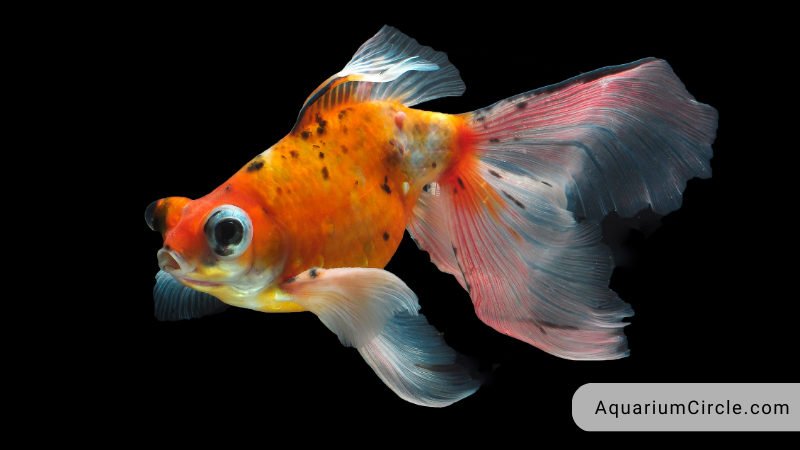
As previously mentioned, the healing of ammonia burns or injuries is by far the most frequent cause of black spots, black smudges, or black patches developing on your goldfish.
Black spots on goldfish frequently do not indicate the existence of an illness, infection, or disease.
However, this idea deserves to be mentioned.
Black spots on fish can be the result of a parasite illness called “black spot disease,” which is a terrible disease.
But, before you assume your fish has black spot illness rather than ammonia burn, you should realize that black spot disease is uncommon. (Unlike ammonia issues, that are quite typical!)
Only if your goldfish is maintained in a tank with snails or in a pond, is it susceptible to black spot illness. This is due to the parasite’s lifecycle, which includes being passed in bird droppings, reaching water, infecting snails, and finally attacking your goldfish.
Other birds consume the diseased fish, and the cycle repeats.
Because it is so uncommon, we highly advise you to examine other options before treating your goldfish for black spot illness. However, if you’re certain that your fish turning black due to disease, a treatment like PraziPro may help.
Overfeeding
How often do you feed your goldfish? Are they fed once, twice, or three times every day? This question is important because moldy food will contaminate the water if excess food is dropped into the water and the fish cannot consume it.
Excess food waste may also block the filter system, reducing filtration effectiveness. As previously explained, this situation will gradually make your goldfish suffer black spots on their body and ammonia toxicity.
Stress
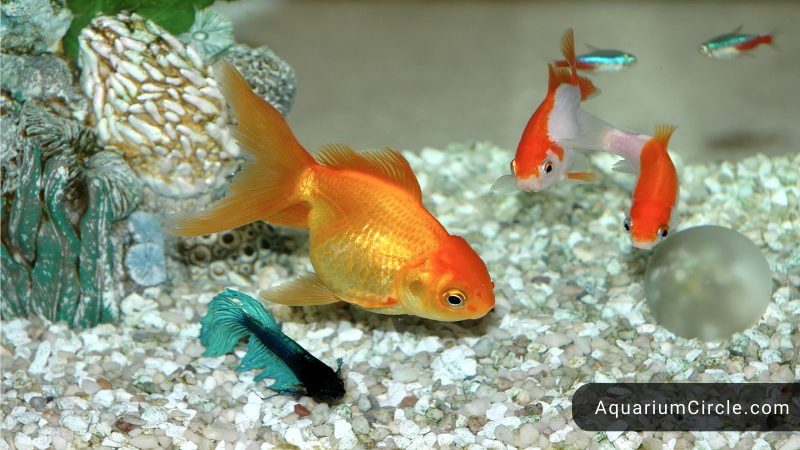
Stress might also be the reason behind your goldfish turning black. Living with an aggressive tank mate, poor water conditions, strong water flow, a new setting, or extended shipping hours can all cause stress in a goldfish.
Goldfish develop black spots on their scales and fins, however this may be avoided by removing the negative stimuli. Your fish’s gorgeous colors will return once they are less stressed.
A bacterial illness can also cause your goldfish’s scales to become black. Because stress affects the immune system, stressed fish are more vulnerable to bacterial infections. However, you may treat bacterial infections using antibacterial medication.
Injuries
Goldfish start turning black when they recover from an injury. Unlike humans, which develop scar tissue or scabs, goldfish have black dots as evidence that they are healing.
You can avoid injuries in the future by eliminating any sharp items or aggressive bullies.
Lack of lighting
Is your hallway or room well-lit? Do you have a fish tank in a dark room in your house? You might try to relocate your aquarium so that it is exposed to more natural light.
The problem is that goldfish generate melanin, a dark pigment that can be found in their skin. Additionally, your goldfish will probably seem darker and maybe even start to become black as it generates more of this dark pigment.
It is, however, a normal process caused by the activity of melanin cells. However, if your finned pets receive a sufficient quantity of natural light, your goldfish will retain their typical, natural colors.
Goldfish may develop more melanin if they are kept in a dark area or are not exposed to natural light.
Fortunately, this can be fixed quickly. Simply move your aquarium to a location where it receives natural light. As an alternative, you may allow the natural light in by opening your curtains and blinds.
Use the finest aquarium LED lights if you are unable to locate a location with adequate exposure to natural light.
Small fish tank size
If you have a 20-gallon tank and 5 goldfish, it is likely that your goldfish do not have enough area to swim.
Black patches are an obvious sign that your pet is agitated due to bad living circumstances, such as a small fish tank.
Ineffective filter
Every aquarist is aware that goldfish generate a considerable amount of biological waste. Of course, possessing an ineffective filter can result in an enormous accumulation of ammonia in your fish tank, which could be the main source of black spots on your goldfish.
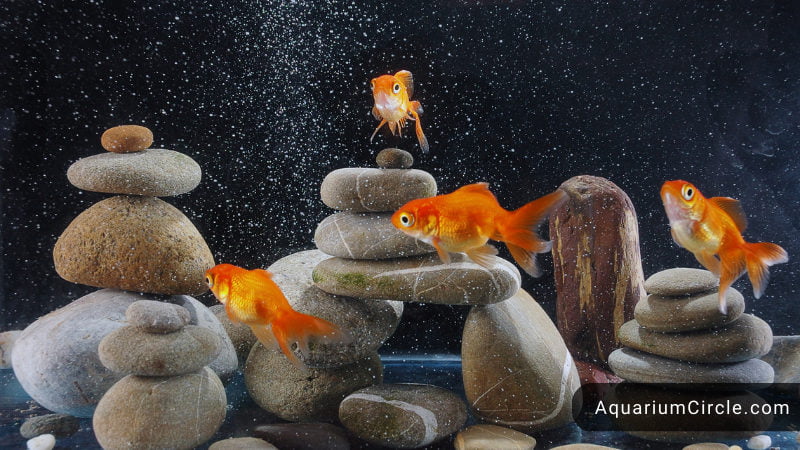
How To Prevent Your Goldfish From Turning Black
Now we have given you several reasons of black color change in goldfish, lets move on with some solutions that can help you cure these black marking and maintain the natural coloration of your fish.
Maintaining water quality
The objective should be to sustain the aquarium water in a healthy state, without any ammonia. This can be achieved by changing a portion of the water regularly, and eliminating uneaten food, plant fragments and fish waste. A test kit for ammonia can be utilized to ensure it is at acceptable levels.
Having enough lighting in your aquarium
Melanin is a natural pigment produced by cells in the skin of fish, amphibians, reptiles, birds and other animals. It is responsible for the darkening of their skin and scales when exposed to light. Goldfish tend to generate more melanin in dimly lit environments as a way of blending into their surroundings, which create chance that your goldfish can develop black spots. In brighter lit tanks, however, the goldfish will not produce as much melanin and may even appear lighter in color due to less pigmentation.
Keeping away from rude tank mates
To avoid stress and bullying, place your goldfish in tanks with other fish that get along with them.
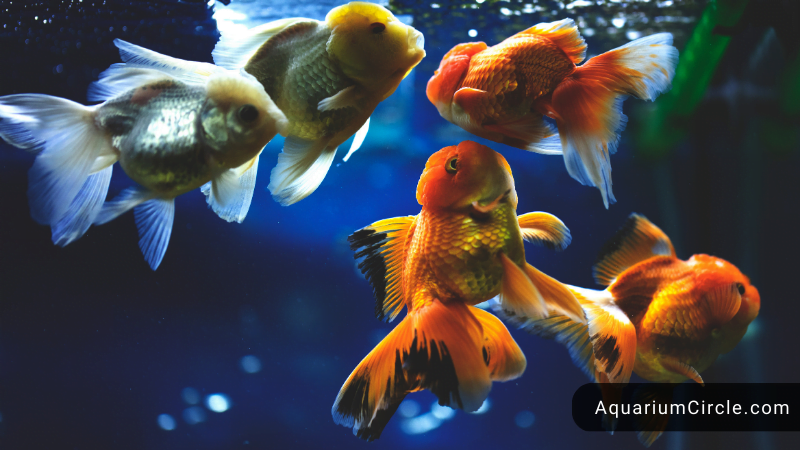
See also: Can Betta Fish Live With Goldfish? – 3 Reasons Why They Are Not Along
Invest in a better filter
If you feel your filter is not doing the job, seek for a more effective one. There are many canister filters that can assist you in keeping your goldfish’s environment healthy and happy.
Get a larger tank
Give your goldfish plenty of room to swim and wander about if you want them to live and grow well.
For example, with a group of 5 goldfish, a bigger 50-gallon aquarium is recommended. You are enabling your goldfish to swim freely by using this size tank. Even better, it lessens the buildup of harmful waste created by your finned friends.
If you have tried all of these treatments and the condition is still there, you should probably speak with a veterinarians or goldfish expert.
Remove the snails from your aquarium
Snails can carry parasites inside of them and pass them on to your goldfish. For this reason, you ought to take them out of the tank.
Keep in mind that you cannot stop a goldfish with a genetic predisposition from getting black spots. For instance, the Shubunkin and Black Moor will eventually get black patches over time due to their genetics.
Videos About Goldfish Turning Black
FAQs
Is it normal for goldfish to change color?
Yes, it is natural for some goldfish to change colors. Goldfish change color naturally as they age, but this usually happens within the first 18 to 24 months of their life. Some black goldfish will turn yellow or orange as they age, and some will lose their black markings on their fins and bodies, which is completely natural.
What is not normal is if your goldfish’s color changes from yellow or orange to black or other colors.
Will black spots on goldfish go away?
If you can get rid of the ammonia in the water, get rid of infections, pests, and anything else is in the way, and the injury heals, the black spots will go away. However, if the underlying issue, such as high levels of ammonia in the water, is not addressed, the black spots will not only persist, but will worsen, and your fish will eventually die.
Do goldfish turn black when stressed?
Yes, goldfish do turn black when stressed. This stress could be the result of an unlisted sickness or of poor water quality. Illness, wrong water parameters, mismatched tank mates, or having too many fish in the aquarium can all create stress.
Reference

Annette M. Chaney is an experienced marine biologist with over 20 years of experience as an aquarist and fishkeeper. She started her first aquarium at a young age, filling it with frogs and goldfish obtained from the ten-cent pet store.
Annette grew up caring for and breeding African Cichlids, which led to a hobby in high school that doubled as a profitable means. Attending Reed College gave her time to solidify herself as an accomplished aquarium caretaker with an eye for sales. After that, from 2009 – 2013, she studied at Roger Williams University – one of the most prestigious universities for Aquaculture and Aquarium in USA. She is the founder of AquariumCircle since 2010.
